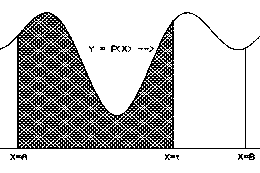Theorem IV.3 in IV.F showed how to determine the area of a planar region bounded by the graph of a positive continuous function, $v,$ the lines $X= a, X=b$, and the X-axis. Using any primitive function (indefinite integral) $S$ for $v$, [i.e., $S'(t)=v(t)$ for all $t$,] the area is $S(b)-S(a)$.
Theorem IV.4 described a situation where a positive continuous function was given on an interval and the issue was whether there was a primitive function (indefinite integral) $F$ for $P$. The result was that there was such a primitive function and in fact one could describe that primitive function $F$ as a function of the number $t$ determined geometrically as the area of the region enclosed by the X-axis, the line $X=A$, the line $X=t$, and the graph of the function $P,$ i.e., the graph of $Y = P(X)$. See Figure V.C.1

Theorem IV.4 THE FUNDAMENTAL THEOREM OF CALCULUS FOR DIFFERENTIAL EQUATIONS (first draft). If $P$ is a positive continuous function on $[A,B]$, then there is a function $F$ with $F'(t) = P(t)$ for all $t$ where $A<t<B$. In fact, $F$ can be defined at $x = t$ to be the area of the region enclosed by the X-axis, the line $X=A$, the line $X=t$, and the graph of the function $P$, i.e., $Y = P(X)$. See Figure V.C.1